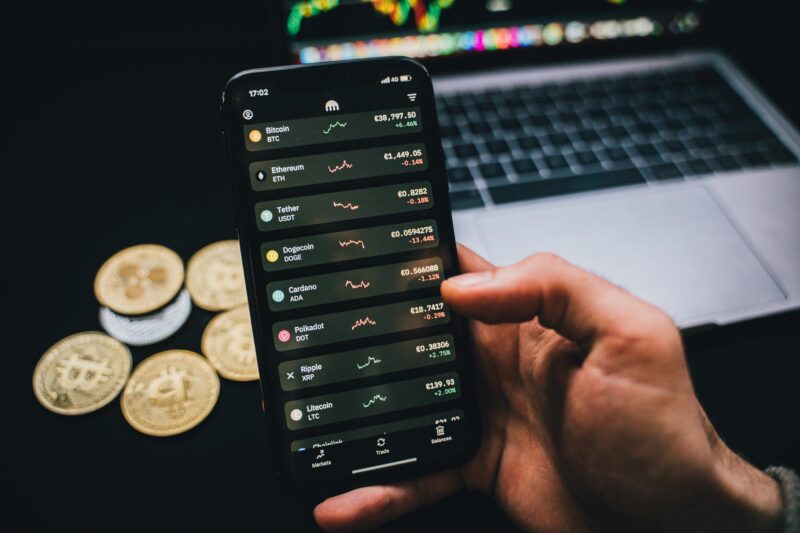Bitcoin, created in 2009, was the first cryptocurrency and remains the most well-known and valuable. Since then, thousands of alternative cryptocurrencies have been developed, each with its own unique features and uses. Now, Investing in cryptocurrency is becoming a nice side income and fills the gaps too between work and life.
Thank you for reading this post, don’t forget to subscribe!
Please support the blog by clicking ads and join the monetize programs , coming soon.
Several factors contribute to Bitcoin’s high price:
- Scarcity: Bitcoin has a limited supply of 21 million coins, which is expected to be reached around the year 2140. This scarcity drives demand and increases its value.
- Network Effect: As more people and businesses adopt Bitcoin, its value increases. This is because it becomes more widely accepted and useful, leading to increased demand.
- Store of Value: Bitcoin is seen as a store of value, similar to gold. This means that people buy and hold Bitcoin as an investment, expecting its value to increase over time.
- Decentralization: Bitcoin is decentralized, meaning it is not controlled by any central authority. This makes it resistant to manipulation and censorship, which increases its appeal to investors.
- Technological Innovation: Bitcoin is based on groundbreaking blockchain technology, which has the potential to revolutionize many industries. This technological innovation drives demand for Bitcoin and its underlying technology.
- Speculation: Some investors buy Bitcoin purely for speculation, hoping to profit from its price increase. This speculative demand can also drive up the price.
It’s important to note that Bitcoin is a highly volatile asset, and its price can fluctuate significantly. Investing in Bitcoin carries significant risk, and it’s important to do your own research before making any investment decisions.
Investing in cryptocurrency
Investing in cryptocurrency can be a complex and risky endeavor, but it can also be a potentially lucrative one. Here are some key things to consider before getting started:
Choosing a Cryptocurrency Exchange:
- Research: Do your research to find a reputable cryptocurrency exchange that is licensed and regulated.
- Security: Look for an exchange with strong security measures to protect your funds.
- Fees: Compare the fees charged by different exchanges, as they can vary significantly.
- User Interface: Choose an exchange with a user-friendly interface that is easy to navigate.
Funding Your Account:
- Deposit Funds: Most exchanges allow you to deposit funds using a variety of methods, such as bank transfer, credit card, or debit card.
- Verification: You will need to verify your identity to comply with regulatory requirements.
Buying Cryptocurrency:
- Choose a Coin: Decide which cryptocurrency you want to invest in based on your research and risk tolerance.
- Place an Order: Once you have chosen a coin, you can place a buy order on the exchange.
- Store Your Cryptocurrency: You can store your cryptocurrency on the exchange or in a digital wallet. Later in other posts I will be explaining more about that.
Important Considerations:
- Volatility: The cryptocurrency market is highly volatile, meaning prices can fluctuate dramatically.
- Risk: Investing in cryptocurrency is a high-risk investment, and you could lose all of your money.
- Security: It is important to keep your cryptocurrency secure by using strong passwords and two-factor authentication.
- Regulation: The regulatory environment for cryptocurrency is constantly changing, so it is important to stay up-to-date on the latest developments.
Additional Tips:
- Diversify Your Portfolio: Don’t put all your eggs in one basket. Invest in a variety of different cryptocurrencies to spread your risk.
- Dollar-Cost Averaging: Invest a fixed amount of money in cryptocurrency at regular intervals, regardless of the price.
- Stay Informed: Keep up-to-date on the latest news and developments in the cryptocurrency market.
- Seek Professional Advice: If you are unsure about investing in cryptocurrency, it is always a good idea to seek advice from a qualified financial advisor.
Remember: Investing in cryptocurrency is a risky endeavor, and you should only invest money that you can afford to lose.
How to store these crypto coins?
Crypto wallets are digital tools that allow you to store, manage, and send cryptocurrencies. Think of them as the digital equivalent of a physical wallet, but instead of holding cash, they hold your digital assets.
Here’s how they work:
- Public and Private Keys: Every cryptocurrency wallet has a pair of keys:
- Public Key: This is like your wallet address. You share it with others to receive cryptocurrency.
- Private Key: This is like your secret password. It gives you control over your cryptocurrency and allows you to make transactions. Keep it safe!
- Types of Crypto Wallets:
- Hot Wallets: These are online wallets that are accessible through a website or app. They are convenient but less secure than cold wallets.
- Cold Wallets: These are offline wallets that store your private keys on a physical device like a USB drive or a piece of paper. They are more secure but less convenient.
Important Considerations:
- Security: Prioritize security by choosing a reputable wallet provider and keeping your private keys safe.
- Fees: Different wallets have different fee structures. Consider the fees when choosing a wallet.
- Features: Look for wallets that offer the features you need, such as multi-currency support, advanced security options, and user-friendly interfaces.
Remember: Crypto wallets don’t actually store your cryptocurrency. They store the keys that allow you to access and control your coins on the blockchain.
Can we cash out these electro coins? How to use it?
Ofcourse we can’t just put a card in a machine and cash some flat money from our crypto coins account, not yet. Still there are several ways to spend cryptocurrency:
1. Direct Payments to Merchants:
- Merchant Adoption: Some businesses and online retailers directly accept cryptocurrency as a form of payment. This is becoming more common, especially for niche products or services.
- Payment Process: When you make a purchase, you’ll typically provide the merchant with your cryptocurrency wallet address. They will then send the corresponding amount of cryptocurrency to your address.
2. Cryptocurrency Debit Cards:
- Card Functionality: These cards, like BitPay or Binance cards allow you to spend cryptocurrency as if it were traditional fiat currency. You can use them at any point of sale that accepts Mastercard or Visa.
- Conversion: The cryptocurrency in your wallet is automatically converted to fiat currency at the point of sale.
3. Cryptocurrency Exchanges and Payment Processors:
- Exchange Services: Some cryptocurrency exchanges offer services to convert your cryptocurrency into fiat currency, which you can then use for traditional purchases.
- Payment Processors: Platforms like BitPay allow you to use cryptocurrency to purchase gift cards or pay bills.
4. Peer-to-Peer Transactions:
- Direct Transfers: You can send cryptocurrency directly to another person’s cryptocurrency wallet address. This is often used for person-to-person payments or remittances.
Important Considerations:
- Merchant Acceptance: The number of merchants accepting cryptocurrency is still relatively limited, though it’s growing.
- Volatility: Cryptocurrency prices can fluctuate significantly, which can impact the value of your purchases.
- Fees: Some methods of spending cryptocurrency may involve transaction fees.
- Security: Always prioritize security when using cryptocurrency, especially when making online transactions.
As cryptocurrency adoption continues to grow, we can expect more and more options for spending it.
How are crypto coins made?
Cryptocurrencies are typically created through a process called mining. Here’s a simplified explanation:
Mining:
- Complex Calculations: Miners use powerful computers to solve complex mathematical problems (if we say so 🙂 , not decrypting user’s data).
- Blockchain Verification: These calculations help verify and add new transactions to the blockchain, a decentralized public ledger.
- Reward: As a reward for their computational efforts, miners receive newly created cryptocurrency.
Key Points:
- Limited Supply: Many cryptocurrencies have a predetermined limit on the total number of coins that can be mined, ensuring scarcity.
- Energy Consumption: Mining can be energy-intensive, especially for cryptocurrencies like Bitcoin.
- Specialized Hardware: Miners often use specialized hardware called ASICs (Application-Specific Integrated Circuits) to increase their efficiency.
- Alternative Methods: Some cryptocurrencies use different methods of creation, such as Proof of Stake, where users stake their existing coins to validate transactions and earn rewards.
It’s important to note that creating a new cryptocurrency from scratch requires significant technical expertise and resources. Most people choose to buy existing cryptocurrencies on exchanges rather than mining them.
Conclusion
In general, we explored the process of how to choose a crypto coins to invest, how to invest and exchange in crypto coins. Also we came across the tip and risks of crypto trading. How to store these coins and how to use and also what does it mean to generate a crypto coins. You can now go ahead and have some investments in small amounts to start carefully. I hope this post encourages you and motivates the trader inside the silent reader of you.
More resources
- Cryptocurrency Trading for Beginners: What You Need to Know! | 01
- Learn Web3 With These Free Resources (Updated November 2024)
- Cryptocurrency – How To Use It More Ideally?
- What are the Risks and Rewards of Buying Newly Launched Cryptocurrencies – Kriptomat
- Digital Currencies | Explainer | Education | RBA
If you have any more questions or need further details, feel free to ask!






Leave a Reply